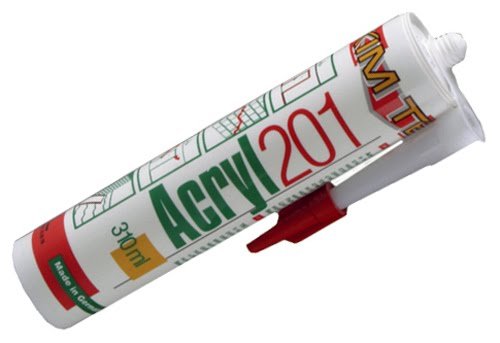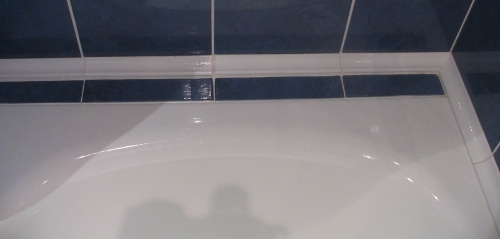The bathroom is such a place in the apartment where there is a risk of constant moisture accumulation. It is undesirable in the bathroom not only from aesthetic considerations. Where the water must necessarily have a mold, and this is a threat to health, and also serious. The weak link is the place where the bath is adjacent to the wall. If it is not sealed correctly, after a while, the problem of moisture will become not only your, but also the next floor below when water accumulated under the bathroom is pounted to them. In order not to urgently make repairs not only in your bathroom, and also in the neighbor, we take a reliably junction between the bathroom and the wall.
Content
Methods seam sealing
one way you can choose when terminating the seam:
- in a time when many of the modern building materials has not yet heard used grout;
- to close the gap with sealant;
- fast and cost-effective way - to foam;
- it is not difficult to install and moldings;
- hold moisture from entering the bath and by means of a tiled border.
Whatever ways you have chosen, it will not be effective if you do not clear the pre-seam. There should not be any trace of old sealing.
We use sealant
You can use this simple material only when the slot is small - about 1.5 cm. Any sealant is applied to the surface perfectly clean, it is only possible to provide high adhesion. So:
- take sandpaper and carefully walk on the junction;
- then also wipe the White Spirit.
Now you can close the baths of the bath with the wall.
What sealant choose? Among the waterproof sealants will have to choose between:
- silicone;
- acrylic;
- combined.
Read the properties.
Siliconee sealant
Buying sealant, you should know that there may be two types of material under this title, as it happens:
- Acidic. If you are not paying attention to the inscription on the cartridge or tube, buy cheaper - acidic, then such an inconsistency threatens the advent of rust around the junction perimeter, as it oxidizes the metal, if only your bath is made of stainless steel. In the process of working with it constantly there is a smell of vinegar.
- Neutral. Among the neutral sealants there is such a subspecies as sanitary. This sealant is more precious acidic, but, just it is suitable for the bath, as it is impossible. When it is used in the bathroom, it should not be lower than +5 and above +40 degrees according to C. There are additives that prevent the appearance of fungus. In other types of sealant there are no such additives.
To make sure that you have a cartridge in your hands with a silicone sanitary sealant from a reliable manufacturer, see what is written on it. Suppose in the composition:
- 45% or more silicone rubber. Ideal - 100%;
- the same indicators on the maintenance of pigment, that is, hydrophobic filler;
- as for the weight, it is no more than 0.5 kg.
These are good features for silicone sealant, it can be bold, and if the indicators are lower, put it back to the shelf. Look also who is the manufacturer. High-quality sealant should have a sufficient degree:
- adhesion;
- waterproof;
- plasticity;
- security.
Trust cause sealants issued by companies such as:
- Henkel. Here, pay attention to the sealant Ceresit CS 25 perfect white, not yellowing with color and having excellent specifications;
- Ciki Fix - Turkey. Specifications are very good. Cheaper than Ceresit.
Acrylic sealant
Acrylic sealants are available:
- resistant moisture;
- unstable.
Since we are talking about the bathroom, then of course, you need to choose the first. This sealant compared to silicone less than elastic. Therefore, if your bathroom is not very stable, then its use will not be effective. Has advantages:
- the junction of the bath and walls, made by acrylic sealant does not change its color;
- on top of the seam you can apply plaster and any paint;
- its composition does not have such a component as organic solvents, so it is safe.
Acrylic waterproof sealants are delivered to our market:
- from the Czech Republic - the company "KVADRO" (KVADRO);
- from Belgium - "For Kemikals" (DL Chemicals) and Kim Tech (Kim Tek);
- from Germany - Dufa (Dűfa), "Jobi" (Jobi);
- russian manufacturer "Sazi". There are others.
All of them are characterized by good performance characteristics, but naturally domestic are less than foreign.
Getting to work
Before starting to close the butt bath and walls, make sure you have:
- special tool, that is, a gun;
- small spatula;
- sponge or rag;
- degreaser: or acetone, or alcohol;
- well, actually the sealant itself.
If all this is available, you can start:
- the fact that the gap must be absolutely clean, we already know;
- to increase the sealance with the surface with the surface, we will defature it: just a thinning solvent or alcohol;
- we are waiting for 30 minutes. While everything will get dry, and during this time we give the sealant to the readiness state:
- Cut the tip - an angle of 45 degrees;
- Together with the sealant in the package there must be a cap. Fix it on the tube;
- We enhance the container with a sealant into the housing of the mounting pistol. The device is ready to work;
- we apply sealant;
- all that is superfluous, we remove a wet spatula;
- we carry out the adjustment of the seam, if necessary;
- from above on sealant, you can stick a border ribbon.
Sealing a slot with mounting foam
Mounting foam is also a good material for sealing the junction between the bathroom and the wall. Apply this material is rational for a wide clearance: a millimeter 3 and more. One should only adhere to several rules:
- where the humidity is increased, the moisture-resistant mounting foam is used;
- she should not get on the wall and to the surface of the bathroom - it is difficult to remove it;
- as with the sealing of a bathroom with any material, the slot needs to be carefully cleaned.
We carry out the work like this:
- cylinder we are subjected to shake;
- let us squeeze the contents of the container very carefully and gradually. The foam layer simply will grow in front of his eyes;
- we are patient and wait until these ugly bugs on the edge of the bathroom are well dried;
- we take the knife and cut what got out for the level of the edge of the bathroom;
- we disguise the seam by moisture-resistant grouting or curb ribbon.
Helpful advice: cylinder with mounting foam hold in such a place where it will acquire a temperature slightly above the one that is currently present in the bathroom. At the exit you will receive a foam more elastic. During the work, keep the balloon upside down. It will also contribute to the best mixing of components.
In the case of sealing the seam by mounting foam, without sealant will not cost, because if you leave, as it is, it will be ugly. Out of position:
- trimming foam to execute just below the level of the edge of the bath;
- go through the surface of the foam glue;
- squeeze the sealant to the entry level coincided with the edge of the bath;
- mix the finger in the soap solution and spend the sealant over the surface. So it will become smooth.
Chemists from Russia, together with their colleagues from the Belgian company Altachem, have developed a chaircon mounting foam specifically for use in our climate.
Excellent mounting foam is produced by STROYSERVISGERMETY. A new development is allocated here: Eco-standards foam, which meets all the requirements of international standards.
Plinth, as one of the embodiments of the junction of the bathroom with a wall
It looks like a PVC profile at the junction of the bath with the wall aesthetic. There are profiles:
- with alent ribbon;
- without tape. This profile is cheaper, but silicone nails must be purchased for it.
It is better to take self-adhesive. Mount it like this:
- the joint, of course, cleaned;
- now you need to cut off a piece of junction. We use the hacksaw for this, and even best do not do this, but buy a ready border with an existing corner;
- the wall and bathroom, in places where the border will be glued to protect the painting tape;
- in the presence of a large width of the gap, blend it with the mounting foam;
- the plinth is warm to activate the self-adhesive tape on it and glue;
- fill the joints with silicone sealant;
- We leave the bathroom for days until everything is dry.
If you bought a plinth without adhesive tape, then do this:
- plot the liquid nails;
- laid plinth;
- few minutes doing nothing, and then presses the plinth;
- trim any excess glue after it hardens.
ceramic border
On sale is a ready and border made of ceramic, which is very convenient. Use it like this:
- a joint sealant is applied;
- on the curb applied tile adhesive;
- where there will be an angle, the border is cut. Angle of 45 degrees;
- sCREEN is hesitated by eats;
- the angles are decorated with shaped parts;
- fill seams using grout.
Creating a border from a tile
If you do not know what to close the joint of the bath-wall because of its big width, then try this method:
- A width of 10 to 30 mm wide is poured by mounting foam;
- After the frost, glue is applied;
- The border tile or the remains of the tile, which were stonamed by the wall.
In case the width of the gap is very big, then:
- under the bath make something like formwork;
- pour the clearance with a mortar from cement and sand;
- when the solution hardens, put the tile. It turns out the shelf.
Sealing the junction between the bathroom and the wall of acrylic
Since the bathroom material acrylic, then the joint acrylic bath and the walls should be chopped with materials with the corresponding composition. Sealants should have a neutral basis. The technology of sealing is the same as for the cast-iron bath:
- stripping surfaces, both baths and walls;
- degreasing;
- squeezing the sealant.



























I got well